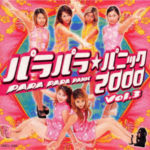Para Para (パラパラ) is a
synchronized dance that originated in Japan. Unlike most club dancing
and rave dancing, there are specific synchronized movements for each
song much like line dancing. Para Para is said to have existed since the
early 1980s when European countries (mostly Italian artists) started
selling Italo disco and Euro disco music in Japan. However, it didn’t
start gaining popularity outside Japan until the late 1990s.
In
Gyaru culture, it was a big part of circle culture to host events (done
by ibe-sa, or event circles) where they would hold parapara
performances.
Since Gyaru were such party animals, and parapara was popular in all areas of clubbing of Japan (with it covering disco, dance, trance and techno) it was inevitable that the two would meet.
As for right now, it’s popularity has seen a big decline with the youth, and the only places you can still see it is at specific para club-events (SEF, Starfire, B-1 Dynamite, Maharaja, wildgalsnight and Agefarre are the most notable). Although some songs are still staples in the scene like “scorpion”.


























Join the conversation!